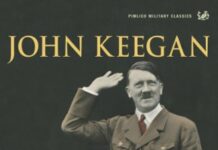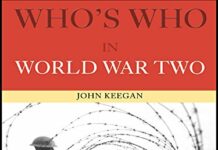
Ebook Info
- Published: 2012
- Number of pages: 516 pages
- Format: PDF
- File Size: 8.55 MB
- Authors: John Keegan
Description
The First World War created the modern world. A conflict of unprecedented ferocity, it abruptly ended the relative peace and prosperity of the Victorian era, unleashing such demons of the twentieth century as mechanized warfare and mass death. It also helped to usher in the ideas that have shaped our times–modernism in the arts, new approaches to psychology and medicine, radical thoughts about economics and society–and in so doing shattered the faith in rationalism and liberalism that had prevailed in Europe since the Enlightenment. With The First World War, John Keegan, one of our most eminent military historians, fulfills a lifelong ambition to write the definitive account of the Great War for our generation.Probing the mystery of how a civilization at the height of its achievement could have propelled itself into such a ruinous conflict, Keegan takes us behind the scenes of the negotiations among Europe’s crowned heads (all of them related to one another by blood) and ministers, and their doomed efforts to defuse the crisis. He reveals how, by an astonishing failure of diplomacy and communication, a bilateral dispute grew to engulf an entire continent.But the heart of Keegan’s superb narrative is, of course, his analysis of the military conflict. With unequalled authority and insight, he recreates the nightmarish engagements whose names have become legend–Verdun, the Somme and Gallipoli among them–and sheds new light on the strategies and tactics employed, particularly the contributions of geography and technology. No less central to Keegan’s account is the human aspect. He acquaints us with the thoughts of the intriguing personalities who oversaw the tragically unnecessary catastrophe–from heads of state like Russia’s hapless tsar, Nicholas II, to renowned warmakers such as Haig, Hindenburg and Joffre. But Keegan reserves his most affecting personal sympathy for those whose individual efforts history has not recorded–“the anonymous millions, indistinguishably drab, undifferentially deprived of any scrap of the glories that by tradition made the life of the man-at-arms tolerable.”By the end of the war, three great empires–the Austro-Hungarian, the Russian and the Ottoman–had collapsed. But as Keegan shows, the devastation ex-tended over the entirety of Europe, and still profoundly informs the politics and culture of the continent today. His brilliant, panoramic account of this vast and terrible conflict is destined to take its place among the classics of world history.With 24 pages of photographs, 2 endpaper maps, and 15 maps in text
User’s Reviews
Reviews from Amazon users which were colected at the time this book was published on the website:
⭐John Keegan’s book expounds on the complex causes leading up to World War I. His writing style is difficult for me to read and I think assumes the reader is fairly knowledgable about the history of European and Balkan history. After reading Chapter 3, The Crisis of 1914 I had to put the following time line and summary to help me understand what happend. I do not claim everything is completely accurate, but I did the best I could to verify this information. World War I Historical Time Line1878 Austro-Hungarian Empire – 5 major religions, a dozen languages. Serbia won independence from the Muslim Ottoman Empire, but a large minority were Austrians from the Habsburgs.1904-1905 Russo-Japanese War occurred.1905 Franco-German North Africa War I occurred.1911 Franco-German Moroccan Crisis occurred.1912-1913 Balkan Wars occurred.1914 June 25, Habsburg Army was on summer maneuvers in Bosnia, part of the former Ottoman Empire occupied by Austria in 1878, annexed in 1908.1914 June 27, Franz Ferdinand and his wife drove to Sarajevo, Bosnia.1914 June 28, was the anniversary of the Turks’ defeat of Serbia in 1389. 5 Serbians and 1 Bosnian Muslim killed Franz Ferdinand and his wife in Sarajevo.Britain, France, Germany, Russia and Austria-Hungary feared the possibility of war. 3 great European Empires were German, Austrian and Russia. Slavs are Austro-Hungarians. Austria-Hungary were dominated by German and Magyars or Hungarians, but populated by a majority of Slav people.1914 July 2, Serbs confessed to killing. Count Berchtold, Austro-Hungary Foreign Minister prepared diplomatic measures against Serbia to persuade Germany to support Austria in an alliance with Bulgaria and Turkey.1914 July 4, Berchtold modified request to Germany to recognize irreconcilable differences between Austria and Serbia1914 July 5, Count Hoyos, Berchtold’s emissary arrived in Berlin and delivered Berchtold memorandum to the Kaiser. Wilhelm II authorized Hoyos to tell Emperor Franz Josef that Austria could rely on Germany’s full support. The offer seemed to imply support for the alliance with Bulgaria and action against Serbia. Hoyos discussions with the Kaiser’s ministers and military advisors General von Falkenhayn, Germany’s Minister of War ask if preparatory measures should be taken and was told not. Bethmann-Hollweg, the Chancellor, had been independently advised by his Foreign Office that Britain would not be involved.1914 July 6, Kaiser told military officers that Russia and France would not be involved and precautionary measures were not necessary.1914 July 7, Imperial Council of Ministers met, Berchtold proposed military action. Tisza held out, he insisted that taking military measures should be held off until the issue of a note of demands.1914 July 9, Franz Josef agreed the any ultimatum be preceded by the note of demands, as Kalman Tisza, Hungarian Prime Minister wanted. Berchtold did not want to hear that and his position steadily hardened towards Field Marshal Conrad , who’s position was war from the outset.1914 July 12, Tisza agreed to a note of demands to be followed by an ultimatum if necessary.1914 July 14, Tisza and Berchtold met again. Tisza won his case against an ultimatum, but the ultimatum would be drafted within 48 hours with a date to be approved at the ministerial meeting on 1914 July 19.1914 July 16, Raymond Poincare, French President left to visit Russia to return July 25. The delivery of an Austrian note to Serbia in the days when Russian and French heads of state would be in intimate contact would likely throw them into diplomatic and strategic conclave. Because of the delays, hope of localize the dispute and of isolating Serbia were diminished.1914 July 19, Tisza objected to any demands that might increase the number of Slavs in Hungary, so it contained no threat of annexation or dismemberment as Conrad desired. The note required all the Serbian government newspaper publish on its front page a condemnation of all propaganda for the separation of any portion of imperial territory, a condemnation to be repeated by the Serbian King in an order of the day to the Serbian army. 10 number demands, of which 5 were elaboration of the propaganda.The Austrian note listed 10 demands, 5 of which elaborated the prohibition of propaganda or subversion:(1) To suppress any publication which incites to hatred and contempt of the Austro-Hungarian Monarchy and the general tendency of which is directed against its territorial integrity;(2) To dissolve immediately the society styled “Narodna Odbrana,” to confiscate all its means of propaganda, and to proceed in the same manner against other societies and their branches in Serbia which engage in propaganda against the Austro-Hungarian Monarchy. The Royal Government shall take the necessary measures to prevent the societies dissolved from continuing their activity under another name and form;(3) To eliminate without delay from public instruction in Serbia, both as regards the teaching body and also as regards the methods of instruction, everything that serves, or might serve, to foment the propaganda against Austria-Hungary;(4) To remove from the military service, and from the administration in general, all officers and functionaries guilty of propaganda against the Austro-Hungarian Monarchy whose names and deeds the Austro-Hungarian Government reserve to themselves the right of communicating to the Royal Government;(5) To accept the collaboration in Serbia of representatives of the Austro-Hungarian Government for the suppression of the subversive movement directed against the territorial integrity of the Monarchy;(6) To take judicial proceedings against accessories to the plot of the 28th of June who are on Serbian territory; delegates of the Austro-Hungarian Government will take part in the investigation relating thereto;(7) To proceed without delay to the arrest of Major Voija Tankositch and of the individual named Milan Ciganovitch, a Serbian State employee, who have been compromised by the results of the magisterial inquiry at Serajevo;(8) To prevent by effective measures the cooperation of the Serbian authorities in the illicit traffic in arms and explosives across the frontier, to dismiss and punish severely the officials of the frontier service at Shabatz Loznica guilty of having assisted the perpetrators of the Serajevo crime by facilitating their passage across the frontier;(9) To furnish the Imperial and Royal Government with explanations regarding the unjustifiable utterances of high Serbian officials, both in Serbia and abroad, who, notwithstanding their official position, have not hesitated since the crime of the 28th of June to express themselves in interviews in terms of hostility to the Austro-Hungarian Government; and, finally,(10) To notify the Imperial and Royal Government without delay of the execution of the measures comprised under the preceding heads.The Austro-Hungarian Government expect the reply of the Royal Government at the latest by 5 o’clock on Saturday evening the 25th of July.1914 July 25 the Note reached Belgrade.1914 July 26-27 the Serbia army mobilised. Russia recalled the youngest reservists.1914 July 28 Austria-Hungary declared war on Serbia.
⭐The world was not the same after the Great War. Traditional European Empires had dissolved. The nature of warfare had changed. The treaty ending this war set up the world for the carnage and the disasters that came in WWII. To understand how we got to where we are now, it is necessity to understand this war. The book provides much of the important detail.
⭐The First World War was the single most important event of the twentieth century. Every event that followed that war, all the other wars, the great movements and revolutions, and even the scientific discoveries and inventions, began in some way, direct or indirect, from the great and terrible happenings of the years 1914-1918. A world in which that war had not occurred would be a very different and perhaps better world. Despite the importance of World War One, I have never known very much about it. I had some knowledge of the general outlines, which countries fought on which side, and which side won. I knew the names of some of the battles, the Somme, Verdun, but nothing in detail. I had some familiarity of the conditions of the Western Front but knew almost nothing at all about the Eastern Front, save that Russia ended up losing. I do not think that I am alone in knowing so little about World War One. The First World War tends to be overshadowed, in contemporary minds, by the still greater and more catastrophic Second World War. Yet, had the first war not been fought, it is very unlikely the second war would have broken out. At first the nature of the combatants would have been different, no Nazis in Germany and no Communist Soviet Union. In the United States, World War One tends to get little attention because we only entered the war in its last year. While the US contribution was crucial to the Allied victory, the war did not hurt us as badly as it did the European powers that fought it. Unlike France, Germany or Britain, America did not lose much of a generation in the fighting.To learn more about this war, I turned to The First World War by the eminent military historian John Keegan. I am happy to report that Mr. Keegan does a truly marvelous job in relating the course of the war, from its beginnings, in the plans by the military staffs of the various combatants to fight the next war, to the assassination of Franz Ferdinand that sparked the war, through the years of trench warfare when massive armies butted heads to no avail, all the way to the last desperate attempt by the Germans to knock Britain and France out of the war before fresh American soldiers arrived to reinforce them. He seems to pay equal attention to both the Western and Eastern fronts. I learned quite a lot about the fighting between Russian and the German-Austrian alliance, not to mention the fighting in the Balkans where the war started.Keegan mostly dwells on the military aspects of the war and has relatively little to say about the domestic politics of the European nations. He does go into some detail about the diplomatic maneuverings the nations of Europe engaged in during the Balkan crisis that led up to the war. It is somewhat poignant to learn that neither side really wanted a general war in Europe, but no one seemed strong enough to end the crisis. Keegan speculates that if Austria-Hungary had launched an immediate invasion of Serbia in retaliation of their support of terrorist activities, the crisis would have ended before it had grown out of control. As it happened, Austria-Hungary waited for support from Germany, and the wait proved fatal for Europe.Keegan challenges some myths and ideas that have grown up about the war. He argues that the various generals were not as incompetent or unconcerned about casualties as is often supposed. As he points out, they tried to fight the war as best they could, but technological development was at an awkward phase for fighting a war. Barbed wired and the machine gun made defended positions nearly impregnable, while the technologies that would have aided the offensive, tanks and airplanes were only beginning to be developed. Improvements in transportation, especially trains, made it possible to send many thousands of men into battle, but the generals had no way to keep in contact with their armies once battle had begun. It was no longer possible for generals to lead their men in person; the battles were too large for that. Telephone and telegraph wires were easily cut. Radio was still in its infancy. The generals were removed from the battlefields because they had no choice. They sent their men to be slaughtered because wars cannot be won without attacking the enemy and attacking the enemy’s positions killed thousands.I enjoyed learning about World War One from John Keegan’s book and I think it serves as an excellent introduction to the war. It covers all the major battles and aspects of the war without getting bogged down in details. Best of all, it can be understood easily even by the reader not familiar with military affairs. I can highly recommend The First World War.
⭐This is a big book to cover a big subject. Unfortunately, there is still not room to cover many of the more minor aspects of the war. There is no discussion of the firearms used by the infantry, the capabilities of the surface ships and submarines, and the war in the air is glossed over. There is no mention of the aerial attacks on the UK by bombers and Zeppelins, and no mention of Lawrence of Arabia. A good overview, but you will have to buy more books to get the detail.
⭐I first discovered John Keegan by reading his underrated book on the American Civil War. It then occurred to me that I had never read a book that covered the whole of World War 1 and sought out a book that could do justice to such a huge topic.Well here it is. John Keegan is a master at summarising complex situations and explaining them in a very accessible way. His chapter on how war broke out and all the points it could have been averted reads like a thriller. Unlike other books I have read on the great war focus on one event or one front which always lurch into intolerably dry lists of divisions and daily movements of troops. Keegan has to round up what happened, to whom and why and always does so without you thinking you have been short changed in depth. This is an amazing feat considering what he has to get through in a little over 400 pages.The writing is effortless and opinion neutral. All sides have victories, all sides have failures and brutality is highlighted when it is warranted. The only revisionist part is where Keegan addresses the controversy surrounding the Western military leaders, pointing out how many anachronisms have been heaped on them. That’s not to say that this is a love letter to Haig but more a realistic assessment of his flaws and strengths.My personal opinion is that World War 1 is the most misunderstood event in history. In that most people have heard about it but then after than the popular view is all gas, trenches, inflexible generals and poetry. Keegan shows how wrong this view is, while never diminishing the horrors of the Western (and Eastern) front he shows there was a lot more going on than men sitting in trenches, being shelled and writing powerful verse.In short this is an essential book on World War 1.If you liked this there’s more historical debate and fun at @HistoryGems on Facebook and Twitter
⭐Well written book. However, to lay the final blame for the start of the war on the inability of politicians and diplomats to extricate themselves from the various alignments and treaties that had been signed or agreed, is to ignore 60 years of German aggression and the wayward mind of the Kaiser.Since the Austrian-Prussian war, the behaviour of Germany was akin to the school bully prodding his schoolmates with a stick to see how they responded.I agree with Keegan that the 2nd WW was just a continuation of the 1st WW. How else could the nation follow Hitler.
⭐I really like this book which is quite detailed and very informative on all aspects of the war revealing details of theatres of war I had not even known about. I only have one criticism and this is regarding the maps included of the battle zones, there are lots of places named on them but they are mainly not the same as those named in the narrative so I had to resort to other sources to identify the actual geographic locations (many thanks to the internet).I requested this book as a Christmas present to go with the DVD set of the BBC’s Great War series I had also requested, which I remember watching when it was first shown on TV. This was a great move since they really do complement one another with extra informatio on the DVD’s as well as being able to see the actual historical people involved,Well recommended
⭐As an excellent overview of the key events, players, places and drivers of WW1 this is superb.Whilst a thorough description, so that we do not lose sight of them, of the horrors of in particular the Western Front is vital, this book is the better for not having them – they are well covered in myriad other accounts of the war. In this book Keegan once again brings his knowledge, research and excellent use of English together to create what is the best WW1 account I’ve yet read (just beating Hasting’s ‘Catastrophe’).
Keywords
Free Download The First World War in PDF format
The First World War PDF Free Download
Download The First World War 2012 PDF Free
The First World War 2012 PDF Free Download
Download The First World War PDF
Free Download Ebook The First World War




